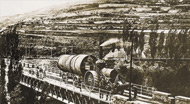History
The story of concrete is closely tied to that of cement, one of its key constituents. It's a story that continues into the present day, as concrete evolves to become the material of a thousand possibilities and a source of constant inspiration for architects.
From cement to concrete |
|
|
Cement was used in ancient Rome but it was only in the 19th century that the ideal composition was studied. Once it had been identified, the practice of molding "cement concrete" quickly spread. Sand and gravel were added to cement and the mixture was molded to obtain imitation stone and cut stone. |
Test your knowledge!Quiz Who invented concrete? Which monuments are built of concrete? How much concrete is produced each year? Test your knowledge! |
Metal reinforcements, a gardener's idea! |
|
|
In 1845, Joseph-Louis Lambot, the "official" inventor of reinforced cement, used wire and mortar to make reservoirs and planters for orange trees. In 1867, Joseph Monier suggested a system of "mobile tubs or basins, made of iron and cement, for use in horticulture", a concept he perfected over the years. Reinforced concrete techniques were mastered a few years later. In 1892, François Hennebique filed the patent that made him the inventor of reinforced concrete. At the World Fair of 1900 he was called the "most important contractor of public works in reinforced concrete". The real adventure of concrete construction began with the new century... |
AnecdoteEdison's molded houses The patents filed by Thomas Edison (1847-1931) for the telegraph, the incandescent light bulb and the phonograph are well-known. However, few people have heard of his idea for low-cost concrete buildings, poured in a single piece. Edison even produced a prototype using metal forms. In the end, his visionary idea fell by the wayside: clearly a man ahead of his time! |
A material comes into its own |
|

|
A French government circular of October 20, 1906 authorized the use of reinforced concrete as a building material. Since 1897, reinforced concrete and its techniques had been part of the curriculum at France's Ecole des Ponts et Chaussées. Future civil engineers who received this training included Eugène Freyssinet, the father of pre-stressed concrete, which was patented in 1929. |
History in motion: constant innovation in concrete |
|
|
The end of the 1980s saw the emergence of high-performance concretes such as ultra-high performance fiber-reinforced concretes and self-placing, self-leveling concretes. |
|





